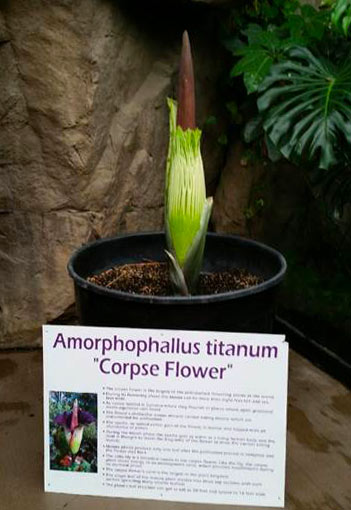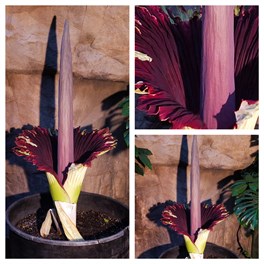Giant corpse flower expected to bloom
Tuesday September 20, 2016
|
UPDATE: OCTOBER 3 |
|
The corpse flower has bloomed! This giant of the plant world releases a smell akin to rotting flesh once it's bloomed. Visit Pugsley today in the Tropical Forest for a view (and a whiff)! Mission #BloomWatch complete. |
 Visitors to Franklin Park Zoo may have a rare opportunity to see a titan arum in bloom in what could be a unique experience to see this giant of the plant world on full display.
Visitors to Franklin Park Zoo may have a rare opportunity to see a titan arum in bloom in what could be a unique experience to see this giant of the plant world on full display.
The plant inside the Tropical Forest is expected to bloom tonight or tomorrow, although this cannot be predicted with absolute certainty. It is estimated that the bloom will measure 3.5 – 4’ in diameter. Franklin Park Zoo is home to five corpse flowers, but the one in the Tropical Forest (affectionately nicknamed Pugsley by staff) is the only one on public display.
Called the Amorphophallus titanum — better known as a titan arum or corpse flower (due to its production of a very pungent aroma like that of a rotting carcass), these are among the most gigantic of flowers – blooms are potentially 9 feet in height and 6 feet across.
Titan arums are very sensitive plants and conditions must be just right for them to bloom. These plants are noted for rapid growth particularly as they near bloom, which can be 4 to 5 inches a day.
Originating from Sumatra, the corpse flower has demanding environmental requirements. This rarely observed blooming phenomenon often goes many years between blooms which last for only 24-48 hours. In the wild, these plants are scattered and the pungent smell can attract pollinators from quite a distance away.
At this stage, it is difficult to predict exactly when, or if, Pugsley will bloom, so we suggest that those interested follow the plant’s development through our Twitter or Facebook pages to stay abreast of this dynamic process and not miss the short bloom period.

 UPDATE: OCTOBER 2
UPDATE: OCTOBER 2